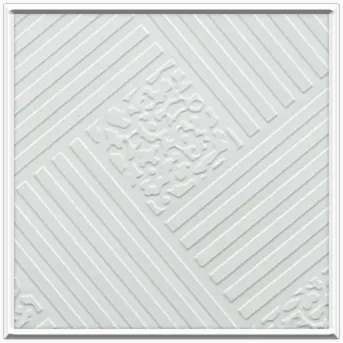Nov . 22, 2024 15:20 Back to list
mineral fiber ceiling specification
Understanding Mineral Fiber Ceiling Specifications
Mineral fiber ceilings are a popular choice in commercial and residential buildings due to their excellent acoustic properties, fire resistance, and availability in a range of aesthetically pleasing designs. These ceilings are composed primarily of natural or synthetic mineral fibers, which provide numerous benefits for interior spaces. When selecting mineral fiber ceilings, it is essential to consider various specifications to ensure they meet the desired performance and aesthetic standards.
One of the primary specifications for mineral fiber ceilings is their acoustic performance. The noise reduction coefficient (NRC) measures how effectively a ceiling can absorb sound. Typically, NRC ratings for mineral fiber ceilings range from 0.70 to 1.00, with higher values indicating better sound absorption capabilities. This characteristic is particularly important in environments such as offices, schools, and hospitals, where controlling noise levels can significantly enhance comfort and productivity.
Fire resistance is another critical specification. Mineral fiber ceilings are generally non-combustible and can be classified according to their fire ratings. The most common ratings include Class A, B, and C, with Class A indicating the highest level of fire resistance. Building codes often require certain fire ratings in commercial settings, making it vital to ensure that the selected mineral fiber ceiling complies with local regulations.
mineral fiber ceiling specification

Durability is also a significant consideration when specifying mineral fiber ceilings. These ceilings should be able to withstand potential impacts, moisture, and mold growth. Some products come with enhanced coatings or treatments to increase their durability and resistance to damage. Additionally, it is crucial to consider the maintenance requirements, as some mineral fiber ceilings may be easier to clean and maintain than others.
Aesthetics play an essential role in the specification of mineral fiber ceilings. They are available in a variety of textures, colors, and sizes, allowing architects and designers to create visually appealing spaces. The design should align with the overall theme of the environment while ensuring that performance criteria are met. It is also worth exploring options such as custom designs or additional features like integrated lighting.
Finally, when selecting a mineral fiber ceiling, sustainability is an increasingly important factor. Many manufacturers are adopting environmentally friendly practices and materials, providing options that contribute to green building certifications such as LEED. Ensuring that the chosen product has a low environmental impact can enhance the overall sustainability of the building project.
In summary, when specifying mineral fiber ceilings, it is crucial to consider acoustic performance, fire resistance, durability, aesthetics, and sustainability. By carefully evaluating these specifications, architects and building professionals can choose the right mineral fiber ceiling to enhance the functionality and beauty of their spaces.
-
Durable Ceiling T Grid Systems | Easy InstallationNewsAug.29,2025
-
PVC Gypsum Ceiling: Durable, Laminated Tiles for Modern SpacesNewsAug.28,2025
-
Pvc Gypsum Ceiling Is DurableNewsAug.21,2025
-
Mineral Fiber Board Is DurableNewsAug.21,2025
-
Ceiling Tile Clip Reusable DesignNewsAug.21,2025
-
Ceiling T Grid Modular DesignNewsAug.21,2025







